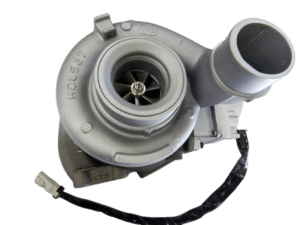Introduction:
The Dodge Ram 2500 and 3500 equipped with the legendary Cummins diesel engine are built to last and haul mountains. But even Goliath had a weakness - we’re talking - Ram VGT Turbo Failures. Let’s break down what’s happening, what years are affected, how you’ll know it’s failing, and what your diesel repair options are for getting back on the road.

What Is the Ram VGT Turbo and Why Does It Fail?
The Variable Geometry Turbo (VGT) is an ingenious piece of engineering that adapts to your driving needs. It tightens up for quick spooling at low RPMs and opens up at higher rpm to allow the engine to breathe better and make more power.
Failures usually boil down to:
- Actuator Problems: The actuator controls the vanes in the turbo. The vanes are kinda like a butterfly valve directing the traffic. But it’s an electronic part trying to survive in a fiery, soot-filled environment at over 1000 degrees fahrenheit. It’s like sending your smartphone to work in a volcano.
- Turbo Itself: bearing failure can quickly lead to devastating turbo failure. When your turbo decides to tap out, you’re left with a sluggish, wheezing truck and likely a lot of smoke.
Years Affected by Ram VGT Turbo Failures:
VGT turbo issues are most commonly reported on Ram 2500 and 3500 models with Cummins engines from 2007.5 to 2022. Essentially, all 6.7L Cummins.
Symptoms of a Failing VGT Turbo
How can you tell if your turbo is waving the white flag and needing a diesel repair? Look out for these tell-tale signs:
- Loss of Power: Your once-powerful Ram feels like it’s towing an invisible trailer or like it never spools up. Wait for it… wait for it…. Wait for it…. huh?
- Excessive Black Smoke: Oh so now you're that guy…
- Check Engine Lights: This can be from the many sensors your engine has, Boost pressure, oxygen sensors, actuator sensors etc.
- Whining or Grinding Noises: Sometimes squeal-like noises or like an electric drill that's on its last leg. This is your turbo grinding metal on metal. Literally eating itself. What's worse is that metal can go into your engine potentially causing catastrophic damage.
- Poor Fuel Economy: You’re burning more diesel than necessary and your wallet is feeling it.
Fixing the Problem: OEM and Aftermarket Replacements
When your VGT turbo fails, you’ve got two main paths: replace it with OEM parts or go aftermarket for an upgrade.
Just the Actuator - OEM Replacements
- Mopar: Offers a factory-spec replacement that’s exactly how they designed it but comes with a premium price tag.
- Dorman: A budget-friendly option that meets OEM standards but might be a Remanufactured unit.
Turbo and Actuator Replacements
Mopar - Yeah it works, it's also expensive.
But come on… As if we needed to tell you this is the time for an upgrade. Where’s the Clarkson in you or Tim Allen… MORE POWA! But also reliability. If the wife asks… its definitely for reliability.
- BD Diesel Turbos: Known for their high-quality VGT replacements and performance-focused non-VGT options for those wanting to ditch the variable vanes altogether. They also make a remanufactured stock unit with improved parts for reliability.
- Fleece Performance: Offers drop-in replacements with improved spool-up, reliability, and airflow. These bad boys support 650hp.
- Industrial Injection: Produces turbos with superior materials and options for higher horsepower builds and are a giant in the diesel aftermarket industry.
Should You Upgrade to a Non-VGT Turbo?
For enthusiasts who crave simplicity and durability, switching to a non-VGT turbo is a viable option. While you may lose some low-end response, non-VGT turbos are known to be more reliable and flow exhaust more efficiently.
Conclusion:
The VGT turbo on your Ram 2500 or 3500 might feel like a ticking time bomb, but knowing the symptoms and your diesel repair options can save you from unexpected downtime. Whether you stick with an OEM replacement or upgrade to a high-performance turbo, your Cummins deserves the best. After all, it’s not just a truck; it’s your workhorse, your road warrior, and maybe even your pride and joy.
The moral of the story is when your turbo starts acting up, don’t wait. Get it fixed or upgraded. Call us or stop by to discuss options and how we can help.

